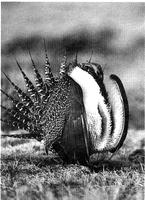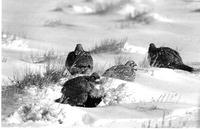|
The Sublette County Journal Volume 4, Number 14 - 12/2/99 brought to you online by Pinedale Online
As an Oregon newspaper asks this question, Game & Fish scrambles to explain a 30% decrease in grouse numbers statewide by Rob Shaul Andy Kerr, an Oregon environmental consultant and veteran of the Pacific Northwest's spotted owl debate of the 1980s, calls sage grouse "the spotted owl of the desert." Last month, a Klamath Falls, Oregon, newspaper, the Herald and News, ran a three-part series exploring whether or not sage grouse were poised to become the focus of the next large environmental conflict in the West. According to Pat Diebert, a biologist with the U.S. Fish and Wildlife Service office in Cheyenne, two environmental groups are gathering information in preparation for petitioning her agency to list the sage grouse as a threatened and endangered species: the American Land Alliance in Oregon, and the Biodiversity Legal Foundation in Boulder, Colorado. The American Land Alliance's contact for sage grouse is Mark Salvo. Calls this week to Mr. Salvo were not returned. In it's story, the Herald and News quotes Mr. Salvo as saying that listing sage grouse is "inevitable." He continues, "The sage grouse is the perfect indicator species for the sagebrush steppe." The ALA has established a website on the issue: www.sagegrouse.org. The phone number listed on the Biodiversity Legal Foundation website has been disconnected. Listing the sage grouse as a threatened or endangered species would have significant impacts on all economic activity on BLM lands in the west, Wyoming and Sublette County. For the livestock industry, the future of grazing would be put into question. The oil and gas industry and recreational activity would also be faced with daunting restrictions and mitigation. Numbers Down Throughout the West
Sage grouse populations are considered "secure" in Oregon, Nevada, Idaho, Montana and Wyoming, but the numbers in this state are also down by up to 30%. According to the Herald and News, it is estimated that there are approximately 20,000 birds in each of these states. Wyoming Numbers Sage grouse seasons were closed in Wyoming from 1937-1948 due to exceptionally low numbers of birds, according to a report compiling all the existing data on Wyoming sage grouse, written by the University of Wyoming Cooperative Wildlife Research Unit. Harvest data suggests that Wyoming's grouse population peaked in the late 1960s and early 1970s. Currently, Wyoming has one of the largest sage grouse populations in the west, says the Game & Fish Department's Joe Bohne, but even Wyoming's numbers are down significantly. As evidence, Mr. Bohne points to an 82% decline in harvested numbers of sage grouse during the hunting season in the 18 years from 1980 through 1998. In 1980, 20,203 Wyoming hunters harvested 85,254 sage grouse. In 1990, 12,981 hunters harvested 41,786 birds. In 1998, just 5,899 hunters harvested only 16,787 sage grouse. Last week, Mr. Bohne told the Casper Star-Tribune that sage grouse populations are doing well in the Lander area, Green River Basin, Red Desert and areas north and south of I-80. Populations have declined significantly in the Big Horn Basin, Laramie Range and North Platte River drainage. The most dramatic decline of sage grouse in Wyoming has occurred in Jackson Hole. The Jackson Hole sage grouse population has declined by 73% since 1990 based on maximum rooster counts on known leks. Problems Found In Sublette County The Game & Fish has identified disturbing trends in Sublette County's own sage grouse population. According to the Pinedale/Jackson Region Job Completion Report for 1996-1998, authored by biologist Doug McWhirter, nesting success and brood sizes have declined significantly since 1990. According to this report, the percentage of successful nesting hens decreased from 94% in 1990 to just 41% in 1997. The percentage rebounded only slightly to 54% in 1998. Sublette County sage grouse brood sizes have also declined significantly since 1990. From 1958-1975, the average sage grouse brood size was 3.4 chicks per hen. In contrast, the 1991-1998 average was 1.7 chicks per hen. Local sage grouse harvest is down 81% from 1983 to 1997, writes Mr. McWhirter. He adds that the number of hunters over the same period declined proportionately. The one bright spot in the local statistics is in the number of roosters in attendance at active leks, which was up 153% in 1998 over the low experienced in 1996. Why The Decline? The reason for the sage grouse decline is not known. Many fingers point to the loss of habitat - i.e. sagebrush - across much of the west due to agriculture and development. The Oregon environmentalists point fingers at livestock grazing. "Removal of livestock is key to restoring sage grouse," Andy Kerr is quoted as saying in the Herald and News story. The theory is that grazing impacts the sagebrush understory of grasses on which sage grouse feed and in which they nest. The University of Wyoming reports that sage grouse nesting success is related to increased residual grass height cover and food forbs, both of which can be impacted by grazing. However, the report goes on to note that grazing pressure during the 1950s and 1960s was "less progressive and more intense" than in the 1980s, yet the sage grouse population was able to rebound from the lows of the 1940s. The authors wonder if the shift of grazing from riparian zones to the sage uplands has been a factor in sage grouse decline. The Game & Fish is focusing on habitat quality, says Joe Bohne. Mr. Bohne is co-chair of a committee that has been formed to create a Wyoming Sage Grouse Conservation Plan. He says all the western states are creating similar plans for their grouse and Wyoming's will serve as an "umbrella document" providing specific guidelines concerning conserving and improving sage grouse habitat. The livestock industry points at predators. According to the University, the golden eagle is the number one predator of adult and juvenile sage grouse over one month old on both summer and winter ranges. Red fox, ravens, and badgers are the most prevalent nest predators identified throughout Wyoming. Biologist Doug McWhirter points to chick survival as the "driving force" of the declining local population of sage grouse. He concludes his report by asking, "How do we improve sage grouse chick survival?" The Politics and Research The spotted owl debate effectively shut down much of the timber industry in the Pacific Northwest, and drastically changed the economies and lifestyles of numerous small towns in Oregon and Washington. The listing of sage grouse as threatened or endangered could have similar impacts on ranching and the oil and gas industry in Sublette County and Wyoming. The Wyoming Wildlife Federation, one of the two major environmental groups in the state, is against listing sage grouse at this point, says Executive Director Kim Floyd. His organization does want to see more research into the decline of grouse and discussions on what types of protections can be put into place to stop the decline in the future. Dan Heilig, Executive Director of the second major environmental group in the state, the Wyoming Outdoor Council, did not return several phone calls asking for comment. According to Joe Bohne, WOC has filed an information request with the G&F to obtain what data the agency has on sage grouse populations. "We're extremely concerned about what the impacts could be to grazing if the sage grouse is listed," says Jim Magagna, executive director of the Wyoming Stockgrowers Association. Mr. Magagna sees similarities in the sage grouse and spotted owl issues in that environmentalists opposed to grazing on public lands are using sage grouse to force cattle off. He believes the real cause of sage grouse decline begins with the increase in predators, especially foxes, eagles, ravens and skunks. The impact to sage grouse populations from predators is a "far more significant impact than the Game & Fish has been willing to recognize," says Jim. Mr. Magagna also points to the change in hunting season. In 1985, G&F moved the sage grouse season opening from the first weekend in September to later in the month. According to Joe Bohne, earlier in the month hens with broods are still concentrated near hay meadows. Later in the month, hens disperse onto sage uplands, therefore decreasing the harvest of female grouse. However, according to Mr. Magagna, earlier in the season it's easier for hunters to distinguish the better tasting younger grouse from the older grouse. It's been his experience that a lot of older grouse are killed but wasted and left in the field as a result of the season change. The Game & Fish hopes to study the specific impacts of grazing on sage grouse beginning next spring. Two ranchers near Lander have agreed to use their lands and cattle in the long-term, 5-year study. Last year, the Audubon Society and Linda Baker of Boulder appealed the Jonah II Natural Gas Project Record of Decision over the proximity of development to existing sage grouse leks. The appeal was denied, but the BLM is funding a $150,000, three-year research project to find out the effects of oil and gas development on sage grouse. The University of Wyoming Cooperative Wildlife Research Unit will complete the study. According to Matt Holleran with the unit, the study will take place north of Jonah and across the highway towards Big Sandy. The research will involve finding existing leks, and staging a drilling operation nearby to record impacts. Rick Robitaille with the Petroleum Association of Wyoming says the possible listing of sage grouse is "certainly a threat," to oil and gas activity on public lands. He resents that Wyoming is being lumped together with other western states that have seen far more drastic decreases in birds. Mr. Robitaille also notes that according to Mr. Bohne, sage grouse populations are doing best in Wyoming where the oil and gas development has been the most active - including Sublette County. "We've looked for years and tried to avoid conflicts when possible," says Mr. Robitaille, "we like to see them flying around too," he concludes. Even if a petition is filed to list sage grouse, it would take a minimum of two years before the birds would be listed and given the full protection of the Endangered Species Act, says the Fish and Wildlife Service's Pat Deibert. She notes that there's no guarantee the bird would be listed in any case. See pinedaleonline.com for more data and information on sage grouse numbers in Wyoming and Sublette County. Available online is "The Sage Grouse: Natural History, Wyoming Studies, Current Issues and Management Considerations" authored by the Wyoming Cooperative Research Unit. Also available online is biologist Doug McWhirter's "Pinedale/Jackson Region Sage Grouse Job Completion Report,1996-1998. Photo credits: WDG&F Photo, WDG&F Photo See The Archives for past articles. Copyright © 1999 The Sublette County Journal All rights reserved. Reproduction by any means must have permission of the Publisher. The Sublette County Journal, PO Box 3010, Pinedale, WY 82941 Phone 307-367-3713 Publisher/Editor: Rob Shaul editor@scjonline.com |

